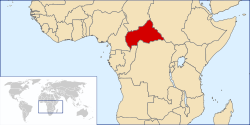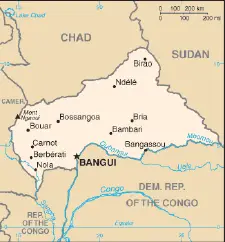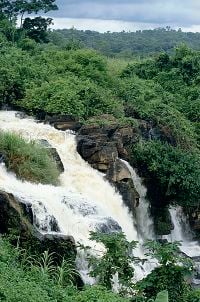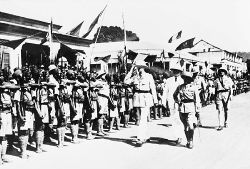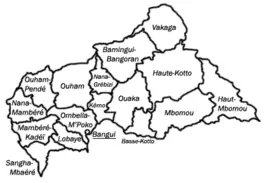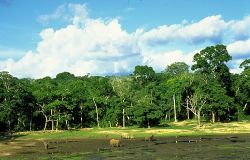Central African Republic
| R√©publique centrafricaine K√∂d√∂r√∂s√™se t√ģ B√™afr√ģka Central African Republic |
||||||
|---|---|---|---|---|---|---|
|
||||||
| Motto: "Unité, Dignité, Travail" (French) "Unity, Dignity, Work" |
||||||
| Anthem: La Renaissance (French) E Zingo (Sango) The Renaissance |
||||||
| Capital (and largest city) | Bangui 4¬į22‚Ä≤N 18¬į35‚Ä≤E | |||||
| Official languages | French Sango |
|||||
| Ethnic groups  | Baya 33% Banda 27% Mandjia 13% Sara 10% Mboum 7% M'Baka 4% Yakoma 4% other 2% |
|||||
| Demonym | Central African | |||||
| Government | Republic | |||||
|  -  | President | Faustin-Archange Touadéra | ||||
|  -  | Prime Minister | Firmin Ngrébada | ||||
| Legislature | National Assembly | |||||
| Independence | ||||||
|  -  | from France | 13 August 1960  | ||||
| Area | ||||||
|  -  | Total | 622,984 km² (43rd) 240,534 sq mi  |
||||
|  -  | Water (%) | 0 | ||||
| Population | ||||||
|  -  | 2021 estimate | 5,357,984[1] (120th) | ||||
|  -  |  census | 3,895,139[2]  | ||||
|  -  | Density | 7.1/km² (221st) 18.4/sq mi |
||||
| GDP (PPP) | 2019 estimate | |||||
|  -  | Total | $4.262 billion[3] (162nd) | ||||
|  -  | Per capita | $823[3] (184th) | ||||
| GDP (nominal) | 2019 estimate | |||||
|  -  | Total | $2.321 billion[3] (163th) | ||||
|  -  | Per capita | $448[3] (181st) | ||||
| Gini (2008) | 56.2 [4] (high)  | |||||
| Currency | Central African CFA franc (XAF) |
|||||
| Time zone | WAT (UTC+1) | |||||
|  -  | Summer (DST) | not observed (UTC+1) | ||||
| Internet TLD | .cf | |||||
| Calling code | +236 | |||||
The Central African Republic is a landlocked country in Central Africa, roughly the size of France. It is bordered by Chad to the north, Sudan to the north and east, the Democratic Republic of the Congo and the Republic of the Congo to the south. Cameroon is to the west.
The Central African Republic that is one of the poorest countries in the world and among the ten poorest countries in Africa. The former French colony has suffered decades of misrule, mostly by military governments, and repression of civil and human rights. The government still does not fully control the countryside, where pockets of lawlessness persist. Though the country has diamonds, uranium, gold, and timber, corruption has been rampant and most of the population is illiterate and desperately poor. Important constraints to economic development include the CAR's landlocked position, a poor transportation system, a largely unskilled work force, and a legacy of misdirected macroeconomic policies.
Geography
The Central African Republic is an entirely landlocked nation. It borders Chad in the north, Sudan in the east, the Republic of the Congo and the Democratic Republic of Congo in the south, and Cameroon in the west.
Two-thirds of the country lies in the basins of the Ubangi River, which then flows south into the Congo River, while the remaining third lies in the basin of the Shari River, which flows north into Lake Chad.
Much of the country consists of flat or rolling plateaus savanna, typically about 1,640 ft (500 m) above sea level. In the northeast are the Fertit Hills, and there are scattered hills in the southwestern part of the country. To the northwest is the Yade Massif, a granite plateau with an altitude of 3,750 feet (1,143 m).
At 240,519 square miles (622,984 sq km), the Central African Republic is the world's 43rd-largest country (after Somalia). It is comparable in size to Ukraine, and is somewhat smaller than the U.S. state of Texas.
Much of the southern border is formed by tributaries of the Congo River, with the Mbomou River in the east merging with the Uele River to form the Ubangi River. In the west, the Sangha River flows through part of the country. The eastern border lies along the edge of the Nile River watershed.
An estimated 8 percent of the country is covered by forest, with the densest parts in the south. The forest is highly diverse and includes commercially important species of Ayous, Sapelli, and Sipo. Lumber poaching is believed to be commonplace.
The country has some of the highest densities of lowland gorillas and forest elephants in Africa.
The climate is generally tropical. The northern areas are subject to harmattan winds, which are hot, dry, and carry dust. The northern regions have been subject to desertification, and the northeast is desert. The remainder of the country is prone to flooding from nearby rivers.
History
Pre-colonial period
Stone tools indicate human habitation for at least eight thousand years. Megaliths near Bouar are at least 2,500 years old. Between about 1000 B.C.E. and 1000 C.E., Adamawa-Eastern-speaking peoples spread eastward from Cameroon to Sudan and settled in most of the territory of the CAR. During the same period, a much smaller number of Bantu-speaking immigrants settled in southwestern CAR and some Central Sudanic-speaking populations settled along the Oubangi River. The majority of the CAR's inhabitants thus speak Adamawa-Eastern languages or Bantu languages belonging to the Niger-Congo family. A minority speak Central Sudanic languages of the Nilo-Saharan family. More recent immigrants include many Muslim merchants who most often speak Arabic or Hausa.
Until the early 1800s, the peoples of the CAR lived beyond the expanding Islamic frontier in the Sudanic zone of Africa and thus had relatively little contact with Abrahamic religions or northern economies. During the first decades of the nineteenth century, however, Muslim traders began increasingly to penetrate the region of the CAR and to cultivate special relations with local leaders in order to facilitate their trade and settlement in the region. The initial arrival of Muslim traders in the early 1800s was relatively peaceful and depended upon the support of local peoples, but after about 1850, slave traders with well-armed soldiers began to penetrate the region. Between c. 1860 and 1910, slave traders from Sudan, Chad, Cameroon, Dar al-Kuti in northern CAR, and Nzakara and Zande states in southeastern CAR exported much of the population of eastern CAR, a region with very few inhabitants today.
French colonialism
European penetration of Central African territory began in the late nineteenth century. Count Savorgnan de Brazza took the lead in establishing the French Congo (with headquarters in the city named after him, Brazzaville) and sent expeditions up the Ubangi River in an effort to expand French territorial claims. King Leopold II of Belgium, Germany and the United Kingdom also competed to establish claims to territory in the Central African region.
In 1889 the French established a post on the Ubangi River at Bangui, the future capital of Ubangi-Shari and the CAR. De Brazza then sent expeditions in 1890-1891 up the Sangha River in what is now southwestern CAR, up the center of the Ubangi basin toward Lake Chad, and eastward along the Ubangi toward the Nile. De Brazza and the pro-colonials in France wished to expand the borders of the French Congo to link up with French territories in West Africa, North Africa, and East Africa. In 1894, the French Congo's borders with Leopold II's Congo Free State and German Cameroon were fixed by diplomatic agreements. Then, in 1899, the French Congo's border with Sudan was fixed along the Congo-Nile watershed, leaving France without its much-coveted outlet on the Nile and turning southeastern Ubangi-Shari into a cul-de-sac.
Once the borders were set, France had to decide how to pay for the costly occupation, administration, and development of the territory. The reported financial successes of Leopold II's concessionary companies in the Congo Free State convinced the French government in 1899 to grant 17 private companies large concessions in the Ubangi-Shari region. In return for the right to exploit these lands by buying local products and selling European goods, the companies promised to pay rent to the colonial state and to promote the development of their concessions. The companies employed European and African agents who frequently used extremely brutal and atrocious methods to force Central Africans to work for them.
At the same time, the French colonial administration began to force Central Africans to pay taxes and to provide the state with free labor. The companies and French administration often collaborated in their efforts to force Central Africans to work for their benefit, but they also often found themselves at odds. Some French officials reported abuses committed by private company militias and even by their own colonial colleagues and troops, but efforts to bring these criminals to justice most often failed. When news of terrible atrocities committed against Central Africans by concessionary company employees and colonial officials or troops reached France and caused an outcry, there were investigations and some feeble attempts at reform, but the situation on the ground in Ubangi-Shari remained essentially the same.
In the meantime, during the first decade of French colonial rule (c. 1900-1910), the rulers of African states in the Ubangi-Shari region increased their slave raiding activities and also their sale of local products to European companies and the colonial state. They took advantage of their treaties with the French to procure more weapons, which were used to capture more slaves. Much of the eastern half of Ubangi-Shari was depopulated as a result of the export of Central Africans by local rulers during the first decade of colonial rule.
During the second decade of colonial rule (c. 1910-1920), armed employees of private companies and the colonial state continued to use brutal methods to deal with local populations who resisted forced labor, but the power of local African rulers was destroyed and so slave raiding was greatly diminished.
In 1911, the Sangha and Lobaye basins were ceded to Germany as part of an agreement giving France a free hand in Morocco, so western Ubangi-Shari came under German rule until World War I, during which France reconquered this territory using Central African troops.
The third decade of colonial rule (1920-1930) was a transition period during which a network of roads was built, cash crops were promoted, mobile health services were created to combat sleeping sickness, and Protestant missions established stations in different parts of the country. New forms of forced labor were also introduced, however, as the French conscripted large numbers of Ubangians to work on the Congo-Ocean Railway. Many of these recruits died of exhaustion and illness. In 1925 the French writer André Gide published Voyage au Congo in which he described the alarming consequences of conscription for the Congo-Ocean railroad and exposed the continuing atrocities committed against Central Africans. In 1928 a major insurrection, the Kongo-Wara 'war of the hoe handle' broke out in western Ubangi-Shari and continued for several years. The extent of this insurrection, perhaps the largest anti-colonial rebellion in Africa during these years, was carefully hidden from the French public because it provided evidence, once again, of strong opposition to French colonial rule and forced labor.
During the fourth decade of colonial rule (c. 1930-1940), cotton, tea, and coffee emerged as important cash crops in Ubangi-Shari and the mining of diamonds and gold began in earnest. Several cotton companies were granted purchasing monopolies over large areas of cotton production and were thus able to fix the prices paid to cultivators in order to assure profits for their shareholders. Europeans established coffee plantations and Central Africans also began to cultivate coffee.
The fifth decade of colonial rule (c. 1940-1950) was shaped by World War II and the political reforms that followed in its wake. In 1946, the inhabitants of French Africa were given the status of citizens. Batthelemy Boganda, a charismatic Catholic priest, was the first representative in the French National Assembly. Some degree of self-government was granted in 1956.
Independence
On December 1, 1958, the colony of Ubangi-Shari became an autonomous territory within the French Community and took the name Central African Republic. The founding father and head of the new government, Barthélémy Boganda, died in a mysterious plane accident in 1959, just eight days before the last elections of the colonial era. On August 13, 1960, the Central African Republic gained its independence. With the backing of the French, David Dacko took power and by 1962 had established a repressive one-party state.
On December 31, 1965, Dacko was overthrown by Col. Jean-Bédel Bokassa, who suspended the constitution and dissolved the National Assembly. Bokassa declared himself president for life in 1972, and named himself Emperor Bokassa I of the Central African Empire on December 4, 1976. A year later, Emperor Bokassa crowned himself in a lavish and expensive ceremony that was largely bankrolled by the French but ridiculed by much of the world.[5]French companies still had significant interest in the CAR's diamonds, uranium, and ivory. As affairs worsened, in 1979 France "restored" Dacko to power. Dacko, in turn, was overthrown two years later in a coup by Gen. André Kolingba, who was frustrated by the slow pace of reforms.
Kolingba suspended the constitution and ruled with a military junta until 1985. He introduced a new constitution in 1986 which was adopted by a nationwide referendum. In 1987, semi-competitive elections to parliament were held, and municipal elections were held in 1988. Kolingba's two major political opponents, Abel Goumba and Ange-Félix Patassé, boycotted these elections because their parties were not allowed to compete.
By 1990, a pro-democracy movement became very active. Pressure from the United States, more reluctantly from France, and other countries and agencies led Kolingba to agree, in principle, to hold free elections in 1992, with help from the UN Office of Electoral Affairs. But Kolingba used the excuse of alleged irregularities to suspend the results of the elections.
When elections were finally held in 1993, again with the help of the international community, Ange-Félix Patassé won the first and second rounds. Despite a new constitution, discontent spread. In 1996-1997, reflecting steadily decreasing public confidence, three mutinies against Patassé's government were accompanied by widespread destruction of property and heightened ethnic tension. On January 25, 1997, the Bangui Peace Accords were signed, which provided for the deployment of an inter-African military mission, known as MISAB. Mali's former president, Amadou Touré, served as chief mediator. The MISAB mission was later replaced by a UN peacekeeping force, MINURCA.
In 1999, notwithstanding widespread public anger in urban centers with his corrupt rule, Patassé won a second term. Rebels stormed strategic buildings in Bangui in an unsuccessful coup attempt in May 2001. Patassé regained the upper hand by bringing in troops from the Democratic Republic of Congo and Libya.
In the aftermath of this failed coup, militias loyal to Patassé sought revenge against rebels in many neighborhoods of the capital, Bangui, that resulted in the destruction of many homes as well as the torture and murder of many opponents. Eventually Patassé came to suspect that General François Bozizé was involved in another coup attempt against him, and Bozizé fled with loyal troops to Chad. In October 2002 Bozizé launched a surprise attack against Patassé, who was out of the country. Libyan troops and some 1,000 Congolese failed to stop the rebels, who took control of the country and overthrew Patassé.
François Bozizé suspended the constitution and named a new cabinet that included most opposition parties. Abel Goumba, the "Mr. Clean" of CAR politics, was named vice-president, which gave Bozizé's new government a positive image. Bozizé established a broad-based National Transition Council to draft a new constitution and announced that he would step down and run for office once the new constitution was approved. Bozizé won a fair election that excluded Patassé and was reelected in May 2005.
In February 2006, there were reports of widespread violence in the northern part of the CAR. Thousands of refugees fled their homes, caught in the crossfire of battles between government troops and rebel forces. More than seven thousand people fled to neighboring Chad. Those who remained told of government troops systematically killing men and boys suspected of cooperating with rebels.[6]
Politics
Politics in the Central African Republic formally take place in a framework of a semi-presidential republic. In this system, the President is the head of state, with a Prime Minister as head of government. Executive power is exercised by the government. Legislative power is vested in both the government and parliament.
Changes in government have occurred in recent years by three methods: violence, negotiations, and elections. A new constitution was approved by voters in a referendum held on 5 December 2004.
The president is elected by popular vote for a six-year term, and the prime minister is appointed by the president. The president also appoints and presides over the Council of Ministers, which initiates laws and oversees government operations. The National Assembly (Assemblée Nationale) has 140 members, elected for a five-year term using the two-round (or Run-off) system.
The legal system is based on French law, though traditional law still applies in rural areas.
Administrative divisions
The Central African Republic is divided into 14 administrative prefectures, along with two economic prefectures and one autonomous commune (Bangui). The prefectures are further divided into 71 sub-prefectures.
Foreign relations
Nineteen countries have resident diplomatic representatives in Bangui, and the C.A.R. maintains approximately the same number of missions abroad. Since early 1989 the government recognizes both Israel and the Palestinian state. The C.A.R. also maintains diplomatic relations with the People's Republic of China. The C.A.R. generally joins other African and developing country states in consensus positions on major policy issues.
The most important countries with which C.A.R. maintain bilateral relations include France, Cameroon, Chad, Democratic Republic of the Congo (DRC), Gabon, Libya, Republic of the Congo, and Sudan.
Economy
The economy of the CAR is dominated by the cultivation and sale of food crops such as cassava, peanuts, maize, sorghum, millet, sesame and plantains. The importance of food crops over exported cash crops is indicated by the fact that the total production of cassava, the staple food of most Central Africans, ranges between 200,000 and 300,000 tons a year, while the production of cotton, the principal exported cash crop, ranges from 25,000 to 45,000 tons a year. Food crops are not exported in large quantities but they still constitute the principal cash crops of the country because Central Africans derive far more income from the periodic sale of surplus food crops than from exported cash crops such as cotton or coffee. Many rural and urban women also transform some food crops into alcoholic drinks such as sorghum beer or hard liquor and derive considerable income from the sale of these drinks.
The per capita income of the CAR is often listed as one of the lowest in the world, but this is based on reported sales of exports and largely ignores the more important but unregistered sale of foods, locally produced alcohol, diamonds, ivory, bushmeat, and traditional medicine. The informal economy is more important than the formal economy for most Central Africans.
Diamonds constitute the most important export of the CAR, frequently accounting for 40-55 percent of export revenues, but an estimated 30-50 percent of the diamonds produced each year leave the country clandestinely.
The CAR is heavily dependent upon multilateral foreign aid and the presence of numerous NGOs, which provide numerous services the government fails to provide. The very presence of numerous foreign personnel and organizations in the country, including peacekeepers and even refugees, provides an important source of revenue for many Central Africans.
The country is self-sufficient in food crops, but much of the population lives at a subsistence level. Livestock development is hindered by the presence of the tsetse fly.
Export trade is hindered by poor economic development and the country's inland location. The natural wilderness regions of this country had good potential as ecotourist destinations. The country is noted for its population of forest elephants. In the southwest, the Dzanga-Sangha National Park is a rainforest. To the north, the Manovo-Gounda St Floris National Park was well populated with wildlife, including leopards, lions, and rhinos. However, the population of wildlife in these parks has severely diminished due to poaching, particularly from neighboring Sudan.
Demographics
The CAR has one of the world's lowest population densities. About two-thirds live in the western part, and most of the rest live in the center. The east is very sparsely populated.
The nation is divided into over 80 ethnic groups, each having its own language. The largest ethnic groups are
- Baya 33 percent
- Banda 27 percent
- Mandjia 13 percent
- Sara 10 percent
- Mboum 7 percent
- M'Baka 4 percent
- Yakoma 4 percent
- Others 2 percent
The Yakoma and other riverine groups were the first to have contact with Europeans and thus to receive a Western education. This led to being favored by the French and to a disproportionate role in the post-independence governments.
Primary school education is compulsory, but up to three-fourths of those eligible do not attend. Students must pay for uniforms, school supplies, and fees, which is an obstacle for many. Males are much more likely to attend school than females.
Religion
About 35 percent of the population follows indigenous beliefs, 25 percent is Protestant, 25 percent is Roman Catholic, and 15 percent is Muslim. Islam is practiced mostly in the northern section and in the capital.
The government allows religious organizations and missionary groups to proselytize freely, build houses of worship, and practice their faith. Religion is an important aspect of life, and the adherents of different faiths generally get along. On the premise that any faith is better than none, people tend to be tolerant of others' beliefs. Most people also believe in witchcraft, the power of ancestors to affect their lives for good or ill, and the prevalence of spirits.
Culture
Languages
There are 68 languages are still spoken in the country, classified into four language families: Nilo-Saharan, Adamawan, Bantu, and Oubanguian. Many people speak more than one language. Swahili, Hausa, Arabic, and Sango also are widely used.
After colonization, people began to communicate in Sango, which some believe emerged when the diverse Africans who were brought in by the Europeans (as militia, workers, and servants) interacted with the inhabitants of the upper Ubangi River. Its use was encouraged by the French but shunned by missionaries until Protestant missionaries and, later, Roman Catholics, began using it in the 1920s. Converts accepted Sango along with the religion, and Christianity helped to spread the language. Written material in Sango was first published by Protestants. Since independence, spoken Sango has become almost universal except among the Mbororo near the Chadian border. In Bangui, Sango is the most frequently used language, even in households where an ethnic language is traditional. In 1996, Sango was declared co-official with French, which is used to communicate with the rest of the world. Sango remains primarily a spoken language, while French is used in written communications, particularly in government and education.
Food
The staple is a doughlike mixture of processed and dried cassava (gozo) or sorghum, accompanied by a sauce made of vegetables, poultry, meat, or fish. Chickens and goats in the villages are used as currency in marriages and as gifts and occasionally are sold for cash; wild game, called bushmeat[7], supplements the rural diet.
Forest dwellers subsist on cassava, bananas, plantains, palm-nut-oil, forest caterpillars, and the leaf of a wild plant (koko). Protein is at a low level in the diet throughout the country. Central Africans mostly grow their own staples (manioc, sorghum, peanuts, sesame, corn, and squash), supplemented by wild tubers, leaves, and mushrooms.
Notes
- ‚ÜĎ CIA, Central African Republic The World Factbook. Retrieved May 12, 2021.
- ‚ÜĎ Central African Republic Population Countrymeters. Retrieved May 12, 2021.
- ‚ÜĎ 3.0 3.1 3.2 3.3 Central African Republic International Monetary Fund. Retrieved May 12, 2021.
- ‚ÜĎ Gini index (World Bank estimate) - Central African Republic The World Bank. Retrieved May 12, 2021.
- ‚ÜĎ Lucy Jones, Ruined Bokassa palace haunts CAR BBC News, July 24, 2001. Retrieved May 12, 2021.
- ‚ÜĎ Thousands flee from CAR violence BBC News, March 25, 2006. Retrieved May 12, 2021.
- ‚ÜĎ Zephania Ubwani, Central Africa: Expert Blames Aids, Ebola to Bush Meat The Citizen, June 6, 2008. Retrieved May 12, 2021.
ReferencesISBN links support NWE through referral fees
- Cutter, Charles Hickman. Africa, 2006. World today series. Harpers Ferry, WV: Stryker-Post Publications, 2006. ISBN 1887985727
- Gide, André. Voyage au Congo. (original 1925) Paris: Gallimard, 1995. ISBN 2070393100 (French)
- Woodfork, Jacqueline Cassandra. Culture and customs of the Central African Republic. Culture and customs of Africa. Westport, CT: Greenwood Press, 2006. ISBN 0313332037
External links
All links retrieved December 3, 2023.
- Central African Republic country profile BBC.
- Central African Republic CIA World Factbook.
Burundi¬†‚ÄĘ Central African Republic¬†‚ÄĘ Chad¬†‚ÄĘ Democratic Republic of the Congo¬†‚ÄĘ Rwanda
Credits
New World Encyclopedia writers and editors rewrote and completed the Wikipedia article in accordance with New World Encyclopedia standards. This article abides by terms of the Creative Commons CC-by-sa 3.0 License (CC-by-sa), which may be used and disseminated with proper attribution. Credit is due under the terms of this license that can reference both the New World Encyclopedia contributors and the selfless volunteer contributors of the Wikimedia Foundation. To cite this article click here for a list of acceptable citing formats.The history of earlier contributions by wikipedians is accessible to researchers here:
The history of this article since it was imported to New World Encyclopedia:
Note: Some restrictions may apply to use of individual images which are separately licensed.


